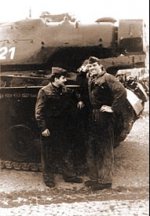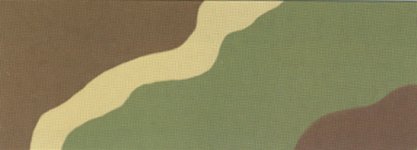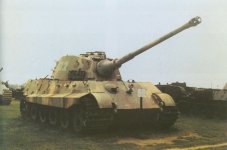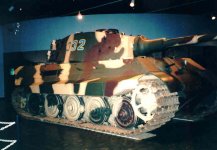You are using an out of date browser. It may not display this or other websites correctly.
You should upgrade or use an alternative browser.
You should upgrade or use an alternative browser.
King Tiger Opinions? Comments (1 Viewer)
- Thread starter Vezzolf
- Start date
Go for Broke
Sergeant Major
- Joined
- Jun 18, 2008
- Messages
- 1,626
To get into a tank you need to be very small
My grandad (5ft 2 - at a push, standing on tip toe) was in the tanks at Monte Cassino
So I guess K&C would make the tank crew smaller
Okay. I stand corrected.
I received the new K/C King Tiger today along with the germans medics and Schiwmmwagen.......The medic set and the schiwmmwagen are excellent+++ but I have mixed feelings regarding the King Tiger.........It does not come up to what my exspectations of it would be.....For me it lacks realistic weathering.... the mud on the fenders is not realistic and in general it is too similar in style to the earlier K/C "Polystone LooK"........the grills are a big improvement..... BUT......IMO it does not measure up to the Tunsian Tiger nor the dessert Panzer IV in quality.......I would not discourage purchasing it and its scale is correct but I was exspecting a "better detailed" less flat appearing model.......IMO.....Thank you Vezzolf
I have to agree, the Tunsian Tiger and Panzer IV both are better looking models than the new King Tiger. The tracks look like the older moldings. Other than the tracks and lack of crew figures, five in the Winter and Tunsian Tigers both of which were less money, its ok. Just my opinion, a step backwards. The other sets, BBG015,17,18,19, and 20, are excellent as the figures seem to get better with each new release.
Thanks
HJ
The smaller number of crew to the K2 is an obvious attempt to keep already high prices somewhat under control. Two more tank crewman could have driven K2 price to near $275 range. The number of new figure sets with 2 figures instead of 3 now seems pretty normal. Extra detail or crewmen aside, the K2 price is as high as I am going right now so 3 crewmen is fine with me. -- lancer
fmethorst
Command Sergeant Major
- Joined
- Feb 18, 2008
- Messages
- 2,492
This is an interesting discussion. I suppose it's only natural that people become more discriminating as prices climb and disposable income shrinks.
When I first saw the KT I thought Wow! K&C has made a historical vehicle (Tiger 313) from the winter of '44/'45. The subdued late war factory paint scheme impressed me. Over time as I saw third party pictures and some doubt began to creep in.
The wheel and track detail that people have mentioned was one thing that jumped out at me. You have to realize I've been collecting HB and HB Gold so my expectations are probabaly unrealistic at this price point. That said the original HB series of tanks finished their production run at $190/ea (cheaper to start) and they always had good wheels and tracks.
Some minor details were missing such as the mounts for the tow cables. I can understand cables being missing since they are removable but the mounts to hold them shouldn't be missing. Perhaps this was more of an economizing concession than an artistic decision.
As pictures began to surface with different lighting I wasn't as impressed with the camouflage as I was initially. While I still think the camouflage pattern is excellent I think the colors are somewhat off. The brown in particular still has that stereotypical excessive red hue. Now I realize people will say the brown was called Rotbraun (Red brown) but the names were unofficial. If you look up RAL 8017 today you will see the name Schokoladenbraun (Chocolate Brown). I suspect there are two factors that lead to the assumption that the brown used on German AFVs was always reddish. One factor is the manner in which it was first applied. As you may recall the brown and green colors were originally issued as a paste to maintenance units to be applied in the field. How the paint was thinned and applied could greatly affect the final color. The brown could vary from rusty orange to rich chocolate. When factories took over all painting tasks in August 1944 the variance in hue was reduced substantially. Generally the colors appeared darker on factory schemes. There was still some variantions due to lot to lot differences caused by Germany's wartime shortages. Another factor is that in some cases wholesale substitution took place. For instance RAL 8012 is a deep red brown and is the color of German primer (Oxirot). Late in the war vehicles would receive a coat of primer and a few patches of Dunkelgelb and Olivgrun, if there was any available, and that was it. Vehicles produced in the Autumn of 1944 appear to have had the most consistant camouflage patterns and colors of any time between between February 1943 and May 1945.
Here are a few pictures.
I find it a shame how many vehicles in museums end up with fantasy camouflage schemes, both from a pattern perspective and a color perspective. One would think a museum would strive to preserve history not revise it.
When I first saw the KT I thought Wow! K&C has made a historical vehicle (Tiger 313) from the winter of '44/'45. The subdued late war factory paint scheme impressed me. Over time as I saw third party pictures and some doubt began to creep in.
The wheel and track detail that people have mentioned was one thing that jumped out at me. You have to realize I've been collecting HB and HB Gold so my expectations are probabaly unrealistic at this price point. That said the original HB series of tanks finished their production run at $190/ea (cheaper to start) and they always had good wheels and tracks.
Some minor details were missing such as the mounts for the tow cables. I can understand cables being missing since they are removable but the mounts to hold them shouldn't be missing. Perhaps this was more of an economizing concession than an artistic decision.
As pictures began to surface with different lighting I wasn't as impressed with the camouflage as I was initially. While I still think the camouflage pattern is excellent I think the colors are somewhat off. The brown in particular still has that stereotypical excessive red hue. Now I realize people will say the brown was called Rotbraun (Red brown) but the names were unofficial. If you look up RAL 8017 today you will see the name Schokoladenbraun (Chocolate Brown). I suspect there are two factors that lead to the assumption that the brown used on German AFVs was always reddish. One factor is the manner in which it was first applied. As you may recall the brown and green colors were originally issued as a paste to maintenance units to be applied in the field. How the paint was thinned and applied could greatly affect the final color. The brown could vary from rusty orange to rich chocolate. When factories took over all painting tasks in August 1944 the variance in hue was reduced substantially. Generally the colors appeared darker on factory schemes. There was still some variantions due to lot to lot differences caused by Germany's wartime shortages. Another factor is that in some cases wholesale substitution took place. For instance RAL 8012 is a deep red brown and is the color of German primer (Oxirot). Late in the war vehicles would receive a coat of primer and a few patches of Dunkelgelb and Olivgrun, if there was any available, and that was it. Vehicles produced in the Autumn of 1944 appear to have had the most consistant camouflage patterns and colors of any time between between February 1943 and May 1945.
Here are a few pictures.
- Color sample showing what I feel are good representations of RAL 8017 and RAL 6003
- Picture of Tiger 332 (same unit as 313) after it was shipped to the US
- Picture of Tiger 332 after Patton museum staff completed their "restoration".
I find it a shame how many vehicles in museums end up with fantasy camouflage schemes, both from a pattern perspective and a color perspective. One would think a museum would strive to preserve history not revise it.
Attachments
amhuff1
Sergeant
- Joined
- Dec 26, 2007
- Messages
- 691
I wasn't sure if I was going to like this at first. I thought it may be too small not at 1/30 scale..... I have been to Aberdeen Proving Grounds many times and have pictures of myself standing in front of a King Tiger.....well guess what I saw it today at a shop and WOW!!!!!!!! It appears fine to me. I really like this tank. One small criticism-do wish more of the side skirts over the treads were in place.
BUT as for everything else a must buy.
BUT as for everything else a must buy.
Canadian Samurai
Staff Sergeant
- Joined
- Jul 17, 2007
- Messages
- 808
As pictures began to surface with different lighting I wasn't as impressed with the camouflage as I was initially. While I still think the camouflage pattern is excellent I think the colors are somewhat off. The brown in particular still has that stereotypical excessive red hue.
This is what is turning me off wanting to purchase this, if you look at these particular photos of the finished model the paintscheme almost appears PINK: http://www.monkeydepot.com/King_Country_BBG016_King_Tiger_Henschel_Turret_p/kc1002.htm Maybe it's just the lighting, but in those pics the pink paint combined with the polka dots makes it look like a bit of a fairy tank ewwww.
DMNamiot
Moderator
- Joined
- Apr 29, 2005
- Messages
- 4,337
Hi CS,
The paint scheme looks right to me and I think the RAL 8017 Redbrown is just washed out by the lighting. I would take a look at one up close and personal before you make a decission.
Also take a look at www.achtungpanzer.com they have a section on the King Tiger and in the gallery section number 1 you will find the real deal. Could well be the vehicle used for the paint scheme.
All the best
Dave
The paint scheme looks right to me and I think the RAL 8017 Redbrown is just washed out by the lighting. I would take a look at one up close and personal before you make a decission.
Also take a look at www.achtungpanzer.com they have a section on the King Tiger and in the gallery section number 1 you will find the real deal. Could well be the vehicle used for the paint scheme.
All the best
Dave
I had a good look at the model on the weekend at the Brisbane Arms & Militaria Fair. It really is a first class model with terrific muted/faded tones and not a hint of Pink  Those that don't like to have so many missing shields may want to display the other side where only two are gone.
Those that don't like to have so many missing shields may want to display the other side where only two are gone.
redhugh
Master Sergeant
- Joined
- Oct 4, 2007
- Messages
- 1,348
I have seen the KT and its not pink

 However Pink can be a popular colour for tanks
However Pink can be a popular colour for tanks
http://en.wikipedia.org/wiki/Monument_to_Soviet_tank_crews
http://www.aleksandramir.info/projects/pinktank/pinktank.html
http://strangelatitudes.wordpress.com/2008/02/09/the-pink-tank-of-prague/
http://en.wikipedia.org/wiki/Monument_to_Soviet_tank_crews
http://www.aleksandramir.info/projects/pinktank/pinktank.html
http://strangelatitudes.wordpress.com/2008/02/09/the-pink-tank-of-prague/
Canadian Samurai
Staff Sergeant
- Joined
- Jul 17, 2007
- Messages
- 808
Thanks guys, good to know it was just a lighting trick. This will be back on my list to get one of these days, if I can ever find the money to pay for it... 
Hi Ya'all I got my KingTiger this weekend and I like it alot. So does my 9 year old God Daughter She also thinks the paint camo may be a bit muted however since no one has any high def. pictures from the period. And weathering did mute things a bit. She's willing to concied it is over all an AWESOME vehicle. And she says "Barbie" likes it alot.
O.C.
O.C.
Fullyautomatic
Sergeant
- Joined
- Apr 22, 2005
- Messages
- 686







Okay my first dealings with photobucket/digital camera and as you can tell I'm not as good as some forum members.Anyways I had not recalled anyone taking pictures of all three King's for comparison sake.First thing I noticed with the new King Tiger is it's weight.Much heavier and if I had a scale I would post the difference. I like the new King and in no way is the paint scheme on the pink side.Like others have mentioned missing track links are lacking especially with the holders present.Crew are very nice and my tank riders are on the way.The other few pic's are the new K&C King Tiger compared to Dragon 1/35 and than a Dragon 1/72 King Tiger.
Enjoy!It's a cold slow day here in NC.
Canadian Samurai
Staff Sergeant
- Joined
- Jul 17, 2007
- Messages
- 808
That's quite a nice collection of king tigers there! Neat to see it compared with the earlier K&C one (which seems to hold up fairly well size-wise) as well as the Dragon models (I was wondering how their 1/35 one compared).
Users who are viewing this thread
Total: 2 (members: 0, guests: 2)





